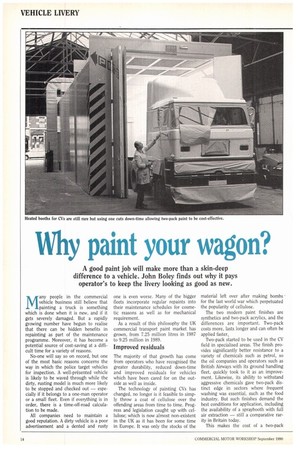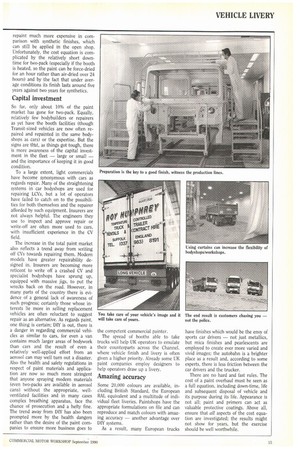Why paint your wagon?
Page 102

Page 103

If you've noticed an error in this article please click here to report it so we can fix it.
A good paint job will make more than a skin-deep difference to a vehicle. John Boley finds out why it pays operator's to keep the livery looking as good as new.
many people in the commercial vehicle business still believe that painting a truck is something which is done when it is new, and if it gets severely damaged. But a rapidly growing number have begun to realise that there can be hidden benefits in repainting as part of the maintenance programme. Moreover, it has become a potential source of cost-saving at a difficult time for a variety of reasons.
No-one will say so on record, but one of the most basic reasons concerns the way in which the police target vehicles for inspection. A well-presented vehicle is likely to be waved through while the dirty, rusting model is much more likely to be stopped and checked out — especially if it belongs to a one-man operator or a small fleet. Even if everything is in order, there is a time-off-road calculation to be made.
All companies need to maintain a good reputation. A dirty vehicle is a poor advertisement and a dented and rusty one is even worse. Many of the bigger fleets incorporate regular repaints into their maintenance schedules for cosmetic reasons as well as for mechanical requirement.
As a result of this philosophy the UK commercial transport paint market has grown, from 7.25 million litres in 1987 to 9.25 million in 1989.
Improved residuals
The majority of that growth has come from operators who have recognised the greater durability, reduced down-time and improved residuals for vehicles which have been cared for on the outside as well as inside.
The technology of painting CVs has changed, no longer is it feasible to simply throw a coat of cellulose over the offending areas from time to time. Progress and legislation caught up with cellulose; which is now almost non-existent in the UK as it has been for some time in Europe. It was only the stocks of the
material left over after making bombs for the last world war which perpetuated the popularity of cellulose.
The two modern paint finishes are synthetics and two-pack acrylics, and the differences are important. Two-pack costs more, lasts longer and can often be applied faster; Two-pack started to be used in the CV field in specialised areas. The finish provides significantly better resistance to a variety of chemicals such as petrol, so the oil companies and operators such as British Airways with its ground handling fleet, quickly took to it as an improvement. Likewise, its ability to withstand aggressive chemicals gave two-pack distinct edge in sectors where frequent washing was essential, such as the food industry. But such finishes demand the best conditions for application, including the availability of a spraybooth with full air extraction — still a comparative rarity in Britain today.
This makes the cost of a two-pack repaint much more expensive in comparison with synthetic finishes, which can still be applied in the open shop. Unfortunately, the cost equation is complicated by the relatively short downtime for two-pack (especially if the booth is heated, so the paint can be force-dried for an hour rather than air-dried over 24 hours) and by the fact that under average conditions its finish lasts around five years against two years for synthetics.
Capital investment
So far, only about 10% of the paint market has gone for two-pack. Equally, relatively few bodybuilders or repairers as yet have the booth facilities (though Transit-sized vehicles are now often repaired and repainted in the same bodyshops as cars) or the expertise. But the signs are that, as things got tough, there is more awareness of the capital investment in the fleet — large or small — and the importance of keeping it in good condition.
To a large extent, light commercials have become synonymous with cars as regards repair. Many of the straightening systems in car bodyshops are used for repairing LCVs, but a lot of operators have failed to catch on to the possibilities for both themselves and the repairer afforded by such equipment. Insurers are not always helpful. The engineers they use to inspect and approve repair or write-off are often more used to cars, with insufficient experience in the CV field.
The increase in the total paint market also reflects a trend away from writing off CVs towards repairing them. Modern models have greater repairability designed in. Insurers are becoming more reticent to write off a crashed CV and specialist bodyshops have sprung up, equipped with massive jigs, to put the wrecks back on the road. However, in many parts of the country there is evidence of a general lack of awareness of such progress; certainly those whose interests lie more in selling replacement vehicles are often reluctant to suggest repair as an alternative. As regards paint, one thing is certain; DIY is out, there is a danger in regarding commercial vehicles as similar to cars, for even a van contains much larger areas of bodywork than cars and the result of even a relatively well-applied effort from an aerosol can may well turn out a disaster. Also the health and safety regulations in respect of paint materials and application are now so much more stringent that anyone spraying modern materials (even two-packs are available in aerosol cans) without the appropriate, wellventilated facilities and in many cases complex breathing apparatus, face the. chance of prosecution and a hefty fine. The trend away from DIY has also been prompted more by the health dangers rather than the desire of the paint companies to ensure more business goes to the competent commercial painter.
The spread of booths able to take trucks will help UK operators to emulate their counterparts across the Channel, where vehicle finish and livery is often given a higher priority. Already some UK paint companies employ designers to help operators draw up a livery.
Amazing accuracy
Some 20,000 colours are available, including British Standard, the European RAL equivalent and a multitude of individual fleet liveries. Paintshops have the appropriate formulations on file and can reproduce and match colours with amazing accuracy — another advantage over DIY systems.
As a result, many European trucks have finishes which would be the envy of sports car drivers — not just metallics, but mica finishes and pearlescents are employed to create ever more varied and vivid images; the autobahn is a brighter place as a result and, according to some experts, there is less friction between the car drivers and the trucker.
There are no hard and fast rules. The cost of a paint overhaul must be seen as a full equation, including down-time, life and subsequent disposal of vehicle and its purpose during its life. Appearance is not all; paint and primers can act as valuable protective coatings. Above all, ensure that all aspects of the cost equation are investigated; the results might not show for years, but the exercise should be well worthwhile.




























































































































